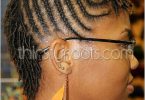Cornrow hairstyles are more than a popular and painstaking, but beautiful way to style hair in the 21st century. In fact, the methodology and practice dates back thousands of years to ancient civilizations in Africa, such as Nigeria and Egypt. You can find detailed braiding among hieroglyphs and sculptures as old as perhaps 500 B.C. and yes, you will even find braids etched into the back of the head of the Sphinx!
The best way to describe this hairstyle is a tight braid that is kept close to the scalp using an underhand and upward motion. Obviously, as the name implies, this process eventually produces a series of continuous, straight rows. Of course, you can also form them into other designs that are more complicated or curvilinear. People like cornrows because you can leave them in for a few weeks at a time and wash them like normal hair. Occasionally, though, you need to apply some oil to the scalp and hair so they don’t dry out.
This type of hairstyle is often used as a base for more adornment too. For instance, in the African tradition, it was common to find beads or shells woven into the braiding. The different accessories and styles were determined by region and gender. In America, though, it didn’t start to become widely popular until the 1960’s when the Black Pride Movement inspired many African Americans to get back in touch with their African roots and don coifs that celebrated the natural texture of their hair.
After the Civil Rights movement, exotic styling beauty shops and salons started to open as African American entrepreneurs aimed to capitalize on the growing trend of cultural revival. These hairstyles can take hours to complete, even by the most skilled hairstyling artisans, but since they need not be taken out for a month or so, people were willing to have their hair done by the best cultural stylists in the area.
These hairstyles are nearly endless, since they start out as a tight braid, but can be shaped and pinned in many different ways. Obviously this was once a crucial component of particular Ethiopian, Nigerian, and other African cultures. In modern times, though, it has been revived again through, of all things, entertainment. In movies, television, and especially through the increasing popularity of hip hop music. This has incited some controversy, though, as many traditionalists argue about whether or not is appropriate for both genders.



